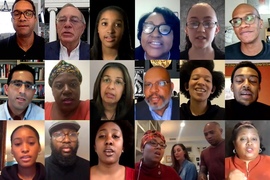Listen. Learn. And, engage. Part of embracing antiracism means having an open mind, as well as engaging in hard conversations. MIT is supporting this process with a Day of Dialogue on Aug. 5, for all staff, faculty, and students. The virtual, live program will feature keynote speakers — including racial equity strategist Darnisa Amante-Jackson — as well as workshops on antiracism. More than 600 community members have already registered, and participants can attend just a portion of the day.
Unlike other conferences, the Day of Dialogue will not feature a closing speaker, and according to committee co-chair La-Tarri Canty, this is intentional. “It’s really important to us … that the conversation not stop after the Day of Dialogue. We want to help keep the momentum going that was created in June,” says Canty, who is the associate dean for intercultural engagement. Her co-chair is Jason McKnight, assistant director of MindHandHeart in the Office of the Provost.
MIT News spoke with Canty and McKnight on what this event means to the MIT community.
Q: What do you want to see the Day of Dialogue accomplish in the MIT community?
Canty: I really hope that people walk away from the day seeing themselves in this work, the work of dismantling racism. The effort requires everyone to be successful. Each person, no matter how knowledgeable they are about diversity, equity, and inclusion, has a stake in this. Everyone is responsible for moving this work forward, which is why I also want people to leave the day with a commitment to engage in at least one action, whether deeply personal or pertaining to something organizational. It is my hope that they leave feeling committed to this work and a part of the effort.
McKnight: My hope, building from what La-Tarri has said, is that people take a risk in at least one conversation over the course of the day and are committed to continuing the difficult conversation. I think so many people feel paralyzed in these discussions, afraid of saying the wrong thing or feeling it’s the “wrong time” to say something, so they never engage in the difficult conversation.
Canty: Going into these conversations, it’s important to bring with you a willingness to be uncomfortable and an acceptance that you will make mistakes. These conversations are challenging, but you have to get to know people and their lived experience if you are going to become culturally fluent.
Q: How would you recommend people engage in difficult conversations around race, especially in a virtual space?
McKnight: I think the virtual space makes these conversations even harder. For me, it’s important to see a person’s nonverbal reactions and to hear their tone. Some self-select to engage via text or email. In general, I would always recommend that any difficult conversation happen in person, physically distant of course, or via a virtual method that allows for you to see the other person’s facial expression and hear their voice. I think it is also a good idea to keep the group small and the conversation at least semiprivate. These conversations are incredibly charged and emotions easily run high.
Canty: I think it’s important to think about the purpose of the conversation. What is your goal? If it’s to change the other person’s mind, what does it mean for you if that doesn’t happen? Will you be OK with just planting a seed? Are you entering the conversation ready to forgive yourself if you make a mistake and ready to forgive them, if they do? These conversations are difficult and can get messy quickly.
Q: What does it mean to be an antiracist?
Canty: Being antiracist is a difficult path for any community. It requires deep reflection and a commitment to being uncomfortable as well as taking concrete steps to change how the community engages with one another. If we are to become a truly antiracist community, it will require everyone to take part.
McKnight: To be antiracist means to actively acknowledge and fight against all forms of racism, subversive and covert. Racism is pervasive and the centering of whiteness, especially in the United States, is second nature due to how we are raised. The centering of whiteness allows me, as a white person, to find Band-Aids that match my skin tone, to perform better on the GRE, and to see at least one person with my same skin tone in the room or Zoom at MIT. Being antiracist means I am aware of the ways in which whiteness is centered in my life, and that I actively work to disrupt and dismantle that centering both personally and systemically.
For more information, contact dayofdialogue@mit.edu.











